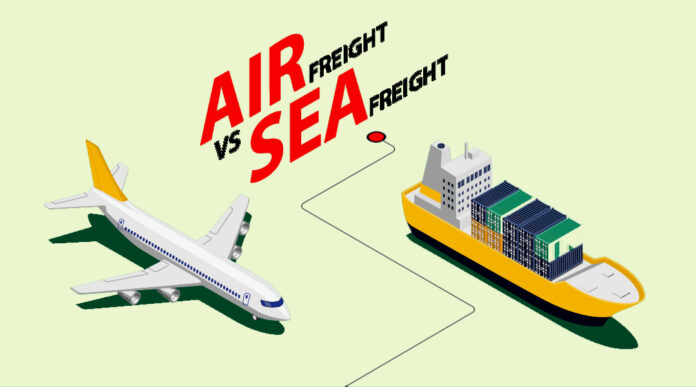Selecting the better freight between sea freight and air freight depends on various factors which include cost, promptness, cargo type, distance, and urgency. Here is a detailed differentiation to help us to decide which one is better for our specific shipping needs:
1. Cost
- Sea Freight:
- Lower Cost: Generally sea freight is a lower cost, especially for large, bulky, and heavy shipments. Sea freight is generally charged based on the size or weight of the cargo, making it a cost-effective option for bulk shipments.
- Ideal for Non-urgent Shipments: Basically when we have large quantities to transport and cost savings are a priority then sea freight is better.
- Air Freight:
- More Expensive: It is more expensive than sea freight due to prompt delivery times, handling, and the premium service it offers.
- Costs: Costs are generally calculated by weight and volume of goods, and air freight is particularly costly for large and heavy shipments, though smaller, urgent items can justify the higher price.
2. Speed
- Sea Freight:
- Slower: It is slower than air freight. Sea freight can take several weeks typically 2-6 weeks which is depending on the origin and destination ports.
- Ideal for Shipments: That is not time-sensitive and can afford to delay for a longer transit time.
- Air Freight:
- Much Faster: Usually taking anywhere from 1 to 7 days which is depending on distance and flight schedules.
- Best for Urgent Shipments: The goods that need to reach their destination quickly. Perfect for perishable goods, high-demand products, or time-sensitive deliveries.
3. Reliability and Risk of Damage
- Sea Freight:
- More Risk of Damage: Due to the longer transit time, exposure to weather conditions, and handling at ports.
- Typically, sea freight needs more careful packaging due to potential coldness, rough seas, or bad handling at ports.
- Air Freight:
- Less Risk of Damage: As air cargo is generally handled more carefully, and goods are in transit for a much shorter period.
- Less Exposure: Weather and environmental risks compared to sea freight.
- However, air freight still needs proper packaging to secure damage during the handling process.
4. Capacity
- Sea Freight:
- Larger Capacity: It is ideal for bulk shipments. Sea freight can handle large volumes of goods, heavy machinery, vehicles, or oversized goods.
- Sea freight containers are different sizes like 20ft, 40ft, etc., which allows us to ship a wide range of goods in large quantities.
- Air Freight:
- Limited Capacity: If we compare it to sea freight. Airplanes have a smaller space for cargo, which means it’s best suited for smaller, high-value items that need to be transported quickly.
- Larger and bulkier items frequently cannot be shipped by air due to the space restrictions.
5. Environmental Impact
- Sea Freight:
- More Eco-friendly: If we compared air freight. Ships produce fewer outflow per ton of cargo than planes, making sea freight a more sustainable option in terms of fuel consumption and greenhouse gas outflow.
- Air Freight:
- Higher Carbon Footprint: Airplanes throw significantly more carbon dioxide per ton of cargo transported, making air freight less environmentally friendly than sea freight.
6. Cargo Type Suitability
- Sea Freight:
- It is best for non-fragile and less time-sensitive goods.
- Ideal for heavy, bulky, and huge numbers of items such as machinery, vehicles, raw materials, textiles, and furniture.
- Suitable for consumer goods or products with longer shelf entities that do not need quick delivery.
- Air Freight:
- It is best for high-value or fragile goods such as electronics, pharmaceuticals, or food products that need to reach their destination quickly.
- Ideal for small, lightweight items that need quick delivery, like documents, emergency shipments, or time-sensitive inventory restocks.
7. Accessibility and Ports/Airports
- Sea Freight:
- Sea freight needs access to ports, so our shipment must be transported to and from the port, which can add to the overall time.
- Sea freight is more commonly used for long-distance international trade because it can serve nearly every major port city across the globe.
- Air Freight:
- Air freight needs access to airports and is mostly available in both major and smaller airports.
- More suitable for countries or regions with good air transport infrastructure.
- It is ideal for global shipping with fast access to international airports.
8. Tracking and Visibility
- Sea Freight:
- Sea freight gives tracking capabilities, but it may not be as real-time as air freight. Shipping schedules can be impacted by weather, and delays are more common.
- Air Freight:
- Air freight generally gives better tracking and real-time visibility. Since air cargo is handled by airlines with advanced tracking systems, updates on the shipment’s location are more frequent and reliable.
Which One Is Better?
- Choose Sea Freight:
- If we have large or bulky shipments.
- If the shipment is non-urgent and can wait for several weeks.
- If Cost savings are a priority.
- If we are shipping non-fragile goods or bulk items.
- Choose Air Freight :
- If we need a prompt and the shipment is time-sensitive.
- If we are shipping high-value, small items, or fragile goods.
- If reliability and quick delivery are important, even at a higher cost.
Conclusion:
- Sea freight: It is a cost-effective option for large, bulky shipments that are not urgent and can be shipped over longer periods of time.
- Air freight: It is ideal for high-value, time-sensitive, or small items that need to be delivered quickly, even though it’s more expensive.
Lastly, the choice between sea freight and air freight depends on our specific shipment needs, including our budget, timeline, and the nature of the goods we are shipping. If we are shipping a mix of goods with varying needs, some businesses even choose to combine both methods which is known as multimodal freight, utilizing air freight for urgent shipments and sea freight for the rest.




